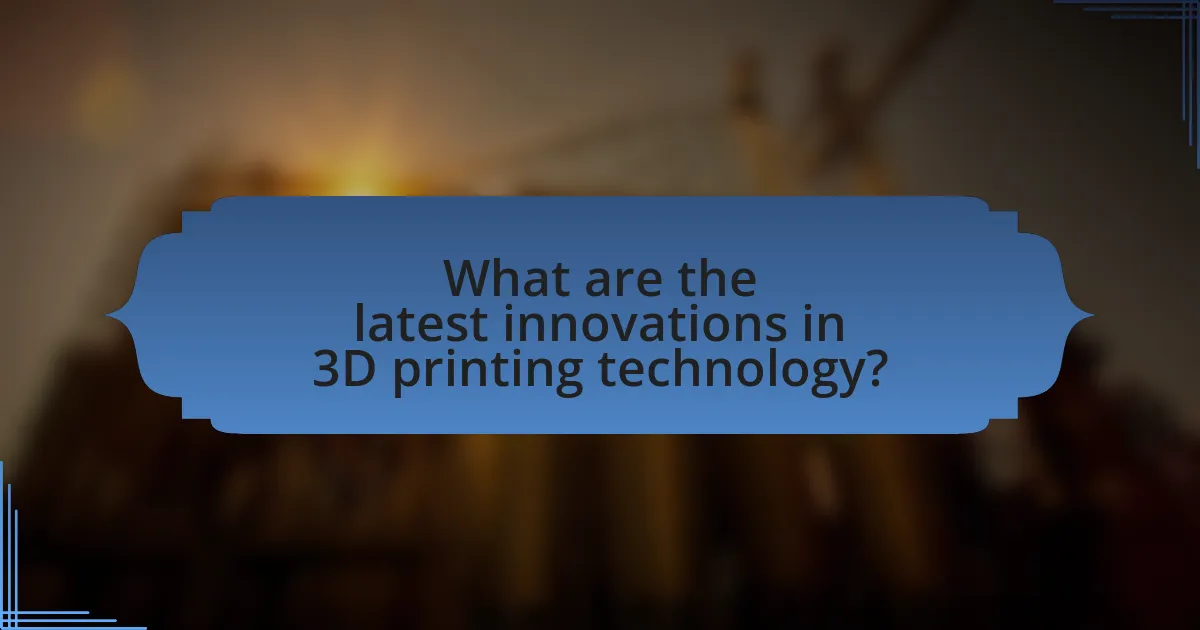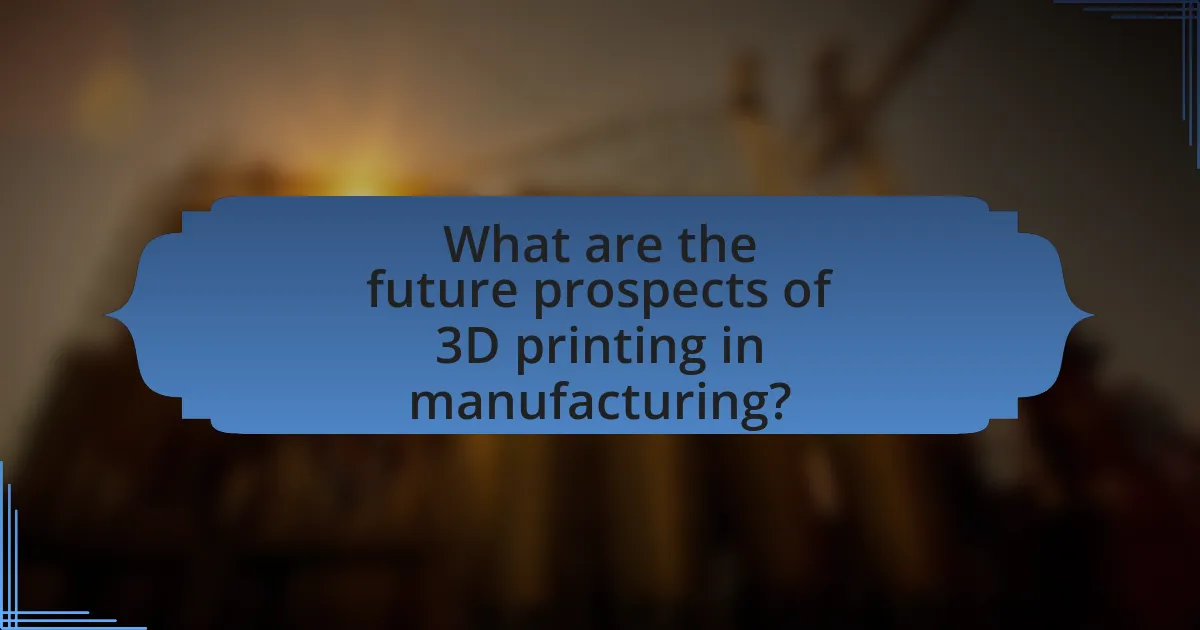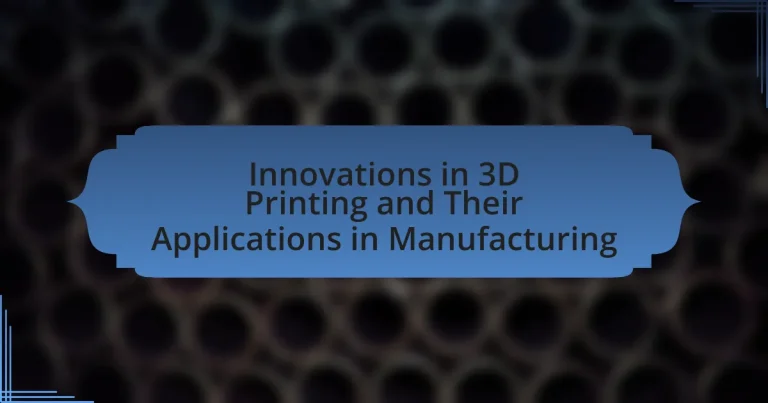The article focuses on the latest innovations in 3D printing technology and their applications in manufacturing. It highlights advancements in materials, such as bio-based and recyclable filaments, and improvements in printing speed and precision through techniques like Continuous Liquid Interface Production (CLIP). The integration of artificial intelligence and automation in 3D printing processes is discussed, emphasizing their role in enhancing efficiency and product quality. Additionally, the article explores the impact of these innovations across various industries, including aerospace, automotive, and healthcare, while addressing challenges and future prospects in the 3D printing landscape.
What are the latest innovations in 3D printing technology?

The latest innovations in 3D printing technology include advancements in materials, such as the development of bio-based and recyclable filaments, and improvements in speed and precision through techniques like Continuous Liquid Interface Production (CLIP). These innovations enable faster production times and the ability to create complex geometries that were previously unattainable. For instance, CLIP technology can produce parts up to 100 times faster than traditional methods, significantly enhancing manufacturing efficiency. Additionally, the integration of artificial intelligence in 3D printing processes allows for real-time monitoring and optimization, further improving the quality and consistency of printed products.
How have advancements in materials impacted 3D printing?
Advancements in materials have significantly enhanced the capabilities and applications of 3D printing. The development of high-performance polymers, metals, and composites has expanded the range of products that can be manufactured, allowing for greater strength, durability, and heat resistance. For instance, the introduction of thermoplastic elastomers has enabled the production of flexible parts, while advancements in metal alloys have facilitated the creation of lightweight yet strong components for aerospace and automotive industries. These material innovations have led to improved print quality, reduced production times, and the ability to create complex geometries that were previously unattainable, thereby transforming manufacturing processes across various sectors.
What new materials are being used in 3D printing?
New materials being used in 3D printing include advanced polymers, metal alloys, ceramics, and bio-based materials. Advanced polymers such as PEEK (polyether ether ketone) offer high thermal resistance and mechanical strength, making them suitable for aerospace and medical applications. Metal alloys like titanium and aluminum are increasingly utilized for their lightweight and durable properties, particularly in the aerospace and automotive industries. Ceramics are being explored for their heat resistance and aesthetic qualities, while bio-based materials, including those derived from renewable resources, are gaining traction for sustainable manufacturing practices. These innovations reflect a growing trend towards enhancing performance and sustainability in 3D printing technologies.
How do these materials enhance the capabilities of 3D printing?
Materials enhance the capabilities of 3D printing by enabling the production of complex geometries, improving mechanical properties, and expanding the range of applications. Advanced materials such as thermoplastics, metals, and composites allow for greater design freedom, which facilitates the creation of intricate structures that traditional manufacturing methods cannot achieve. For instance, the use of carbon fiber-reinforced polymers increases strength and stiffness, making parts more durable while remaining lightweight. Additionally, materials like bio-based filaments and metal powders enable the production of functional prototypes and end-use parts in industries such as aerospace and healthcare, demonstrating the versatility and adaptability of 3D printing technologies.
What technological advancements have improved 3D printing processes?
Technological advancements that have improved 3D printing processes include the development of faster printing technologies, enhanced materials, and advanced software algorithms. Faster printing technologies, such as Continuous Liquid Interface Production (CLIP) and Multi Jet Fusion (MJF), significantly reduce production time compared to traditional methods. Enhanced materials, including high-strength polymers and metal alloys, expand the range of applications for 3D printing, allowing for stronger and more durable products. Advanced software algorithms improve design capabilities and optimize print paths, resulting in higher precision and reduced material waste. These advancements collectively contribute to more efficient and versatile 3D printing processes in manufacturing.
How has software development influenced 3D printing?
Software development has significantly influenced 3D printing by enhancing design capabilities, streamlining workflows, and improving printing accuracy. Advanced software tools, such as CAD (Computer-Aided Design) programs, allow users to create intricate 3D models that can be directly translated into printable files. Additionally, slicing software optimizes the model for printing by determining the best layer height, infill patterns, and support structures, which increases efficiency and reduces material waste. The integration of software with 3D printers has also enabled real-time monitoring and adjustments during the printing process, leading to higher quality outputs. According to a report by Wohlers Associates, the global 3D printing market is projected to reach $35.6 billion by 2024, largely driven by advancements in software that facilitate more complex and precise manufacturing processes.
What role do automation and AI play in modern 3D printing?
Automation and AI significantly enhance modern 3D printing by improving efficiency, precision, and scalability. Automation streamlines the printing process, allowing for faster production times and reduced human error, while AI optimizes design and material selection through advanced algorithms. For instance, AI-driven software can analyze complex geometries and suggest modifications that enhance structural integrity, leading to better performance of printed parts. Additionally, automation technologies enable continuous monitoring and adjustment of printing parameters in real-time, ensuring consistent quality across batches. These advancements collectively contribute to the growing adoption of 3D printing in various manufacturing sectors, demonstrating the critical role of automation and AI in driving innovation and productivity.
What are the emerging trends in 3D printing technology?
Emerging trends in 3D printing technology include the increased use of bioprinting for medical applications, advancements in materials such as metal and composite filaments, and the integration of artificial intelligence for design optimization. Bioprinting is revolutionizing tissue engineering, with studies showing that it can create complex tissue structures, enhancing regenerative medicine. The development of high-performance materials allows for stronger and more durable printed parts, which is crucial for industries like aerospace and automotive. Additionally, AI-driven software is streamlining the design process, enabling faster prototyping and reducing material waste, thereby improving efficiency in manufacturing.
How is sustainability being integrated into 3D printing innovations?
Sustainability is being integrated into 3D printing innovations through the development of eco-friendly materials and energy-efficient printing processes. For instance, bioplastics derived from renewable resources, such as cornstarch or sugarcane, are increasingly used in 3D printing, reducing reliance on petroleum-based plastics. Additionally, advancements in energy-efficient printing technologies, like low-energy consumption printers and optimized printing techniques, contribute to lower carbon footprints. Research indicates that using 3D printing can minimize material waste by up to 90% compared to traditional manufacturing methods, further enhancing sustainability in the industry.
What future technologies are expected to revolutionize 3D printing?
Future technologies expected to revolutionize 3D printing include advanced materials, multi-material printing, and artificial intelligence integration. Advanced materials, such as bio-based and smart materials, enhance the functionality and sustainability of printed objects. Multi-material printing allows for the creation of complex structures with varying properties in a single print, significantly expanding design possibilities. Artificial intelligence integration optimizes printing processes and improves quality control by predicting failures and adjusting parameters in real-time. These advancements are supported by ongoing research and development in the field, indicating a transformative impact on manufacturing practices.
How are innovations in 3D printing applied in manufacturing?

Innovations in 3D printing are applied in manufacturing through techniques such as additive manufacturing, which allows for the creation of complex geometries that traditional methods cannot achieve. This technology enables rapid prototyping, reducing the time from design to production, and allows for customization of products to meet specific customer needs. For instance, companies like General Electric utilize 3D printing to produce lightweight components for jet engines, resulting in significant fuel savings and improved performance. Additionally, 3D printing reduces material waste, as it only uses the necessary amount of material for each part, which is a critical factor in sustainable manufacturing practices.
What industries are leveraging 3D printing innovations?
Various industries are leveraging 3D printing innovations, including aerospace, automotive, healthcare, and consumer goods. In aerospace, companies like Boeing and Airbus utilize 3D printing for lightweight components, enhancing fuel efficiency and reducing costs. The automotive industry employs 3D printing for prototyping and producing complex parts, with manufacturers such as Ford and BMW integrating this technology into their production lines. In healthcare, 3D printing is used for creating custom prosthetics and implants, with firms like Stratasys leading advancements in bioprinting. Additionally, the consumer goods sector utilizes 3D printing for rapid prototyping and personalized products, exemplified by brands like Nike and Adidas. These industries demonstrate the transformative impact of 3D printing on manufacturing processes and product development.
How is 3D printing transforming the aerospace industry?
3D printing is transforming the aerospace industry by enabling the production of lightweight, complex components that enhance performance and reduce costs. This technology allows for rapid prototyping, which accelerates the design process and facilitates customization of parts, leading to improved efficiency in manufacturing. For instance, companies like Boeing and Airbus have adopted 3D printing to create intricate parts such as fuel nozzles and brackets, resulting in weight reductions of up to 55% and significant savings in material costs. Additionally, 3D printing reduces waste, as it uses only the necessary material for production, aligning with sustainability goals in aerospace manufacturing.
What impact does 3D printing have on the automotive sector?
3D printing significantly impacts the automotive sector by enabling rapid prototyping, customization, and lightweight component production. This technology allows manufacturers to create complex parts quickly, reducing development time from months to weeks. For instance, companies like Ford have utilized 3D printing to produce prototype parts in just a few days, streamlining the design process. Additionally, 3D printing facilitates the production of lightweight components, which can enhance fuel efficiency and performance; for example, BMW has implemented 3D-printed parts in their vehicles to reduce weight without compromising strength. These advancements illustrate how 3D printing is transforming manufacturing practices in the automotive industry.
What are the benefits of using 3D printing in manufacturing?
The benefits of using 3D printing in manufacturing include reduced production costs, increased design flexibility, and faster prototyping. 3D printing allows for the creation of complex geometries that traditional manufacturing methods cannot achieve, enabling innovative product designs. Additionally, it minimizes material waste by using only the necessary amount of material for each part, which can lead to significant cost savings. According to a study by Wohlers Associates, 3D printing can reduce lead times by up to 90%, allowing companies to bring products to market more quickly.
How does 3D printing reduce production costs?
3D printing reduces production costs by minimizing material waste and lowering labor expenses. Traditional manufacturing often involves subtractive processes that generate significant waste, whereas 3D printing builds objects layer by layer, using only the necessary amount of material. According to a study by Wohlers Associates, 3D printing can reduce material costs by up to 90% in some applications. Additionally, 3D printing streamlines production by enabling rapid prototyping and reducing the need for complex tooling, which further decreases labor costs and time. This efficiency leads to faster turnaround times and lower overall production expenses.
What advantages does 3D printing offer in terms of design flexibility?
3D printing offers significant advantages in design flexibility by enabling the creation of complex geometries that traditional manufacturing methods cannot achieve. This technology allows for the production of intricate shapes, internal structures, and customized designs tailored to specific needs, which enhances innovation in product development. For instance, according to a study published in the journal “Additive Manufacturing,” 3D printing can produce parts with complex lattice structures that reduce weight while maintaining strength, demonstrating its capability to optimize designs for performance and efficiency.
What challenges do manufacturers face when adopting 3D printing?
Manufacturers face several challenges when adopting 3D printing, including high initial costs, material limitations, and a lack of skilled workforce. High initial costs stem from the investment required for advanced 3D printing equipment and technology, which can be prohibitive for smaller manufacturers. Material limitations refer to the restricted range of materials that can be effectively used in 3D printing, impacting the quality and functionality of the final products. Additionally, the lack of a skilled workforce poses a significant barrier, as many manufacturers struggle to find employees with the necessary expertise in 3D printing technologies and processes. These challenges can hinder the widespread adoption and integration of 3D printing in manufacturing operations.
How can manufacturers overcome the limitations of 3D printing technology?
Manufacturers can overcome the limitations of 3D printing technology by investing in advanced materials and hybrid manufacturing processes. Advanced materials, such as high-performance polymers and metal alloys, enhance the mechanical properties and thermal resistance of printed parts, addressing issues like strength and durability. Hybrid manufacturing, which combines additive and subtractive techniques, allows for greater precision and the ability to produce complex geometries that traditional methods struggle with. For instance, a study by the National Institute of Standards and Technology found that integrating 3D printing with CNC machining can significantly improve the dimensional accuracy of parts, demonstrating a practical approach to mitigating the inherent limitations of 3D printing.
What regulatory issues must be considered in 3D printing applications?
Regulatory issues in 3D printing applications include compliance with safety standards, intellectual property rights, and material regulations. Safety standards ensure that products manufactured through 3D printing do not pose risks to users, which is critical given the diverse applications ranging from medical devices to consumer goods. Intellectual property rights are essential to protect designs and innovations, as 3D printing can easily replicate complex items, raising concerns about copyright infringement. Additionally, regulations regarding the materials used in 3D printing, such as biocompatibility for medical applications, must be adhered to in order to meet health and safety requirements. These regulatory considerations are vital for ensuring that 3D printing technologies are used responsibly and ethically in manufacturing.
What are the future prospects of 3D printing in manufacturing?

The future prospects of 3D printing in manufacturing are highly promising, with advancements expected to enhance customization, reduce waste, and streamline production processes. As industries increasingly adopt additive manufacturing technologies, the ability to create complex geometries and lightweight structures will lead to significant improvements in product performance and efficiency. According to a report by Wohlers Associates, the global 3D printing market is projected to grow from $12.6 billion in 2020 to over $35 billion by 2024, indicating a strong trend towards wider adoption across various sectors, including aerospace, automotive, and healthcare. This growth is driven by the technology’s potential to lower costs and lead times while enabling on-demand production, which is particularly valuable in today’s fast-paced market environment.
How is the market for 3D printing expected to evolve?
The market for 3D printing is expected to evolve significantly, driven by advancements in technology and increasing adoption across various industries. According to a report by MarketsandMarkets, the global 3D printing market size is projected to grow from $13.7 billion in 2020 to $34.8 billion by 2026, at a compound annual growth rate (CAGR) of 16.0%. This growth is fueled by innovations such as improved materials, faster printing speeds, and enhanced software solutions, which are making 3D printing more accessible and efficient for manufacturing applications. Additionally, sectors like aerospace, automotive, and healthcare are increasingly integrating 3D printing for prototyping, tooling, and production, further contributing to market expansion.
What growth trends are anticipated in the 3D printing industry?
The 3D printing industry is anticipated to experience significant growth trends, including increased adoption across various sectors, advancements in materials, and enhanced printing technologies. According to a report by MarketsandMarkets, the global 3D printing market is projected to grow from $13.7 billion in 2020 to $34.8 billion by 2026, reflecting a compound annual growth rate (CAGR) of 16.0%. This growth is driven by the rising demand for customized products, the expansion of additive manufacturing in aerospace and healthcare, and the development of new materials that improve the performance and capabilities of 3D printing.
How will consumer demand shape the future of 3D printing?
Consumer demand will significantly shape the future of 3D printing by driving innovation and customization in manufacturing processes. As consumers increasingly seek personalized products, manufacturers will adapt their 3D printing capabilities to meet these demands, leading to advancements in materials and technologies. For instance, a report by Wohlers Associates indicates that the global 3D printing market is projected to grow from $12.6 billion in 2020 to over $35 billion by 2024, largely fueled by consumer preferences for tailored solutions. This shift will encourage companies to invest in more efficient and versatile 3D printing systems, ultimately transforming production methods to be more responsive to individual consumer needs.
What innovations are on the horizon for 3D printing technology?
Innovations on the horizon for 3D printing technology include advancements in materials, speed, and multi-material printing capabilities. New materials such as bio-based plastics and metal alloys are being developed to enhance the strength and functionality of printed objects. Additionally, technologies like Continuous Liquid Interface Production (CLIP) are significantly increasing printing speeds, allowing for faster production times. Furthermore, the integration of multi-material printing enables the creation of complex structures with varying properties in a single print, which is crucial for applications in aerospace and healthcare. These innovations are supported by ongoing research and development efforts in the field, indicating a robust future for 3D printing in manufacturing.
How might advancements in bioprinting change manufacturing?
Advancements in bioprinting are likely to revolutionize manufacturing by enabling the production of complex biological structures and tissues on demand. This technology allows for the precise layering of living cells and biomaterials, which can lead to the creation of custom organs and tissues for medical applications, significantly reducing the reliance on organ donors. For instance, research from the Wake Forest Institute for Regenerative Medicine has demonstrated the successful bioprinting of human tissues, showcasing the potential for personalized medicine and tailored treatments. Additionally, bioprinting can streamline the manufacturing process by reducing waste and increasing efficiency, as it allows for the direct fabrication of biological products without the need for traditional assembly lines.
What potential does 4D printing hold for future applications?
4D printing holds significant potential for future applications by enabling materials to change shape or function over time in response to environmental stimuli. This capability can revolutionize fields such as healthcare, where self-assembling medical devices could adapt to patient needs, and construction, where structures could respond to weather conditions for enhanced durability. Research indicates that 4D printing can lead to more efficient manufacturing processes, reducing waste and energy consumption, as materials can be designed to transform only when necessary. Additionally, the integration of smart materials in 4D printing allows for the development of products that can repair themselves or adjust their properties, further expanding the scope of applications across various industries.
What best practices should manufacturers follow when implementing 3D printing?
Manufacturers should follow best practices such as conducting thorough research on materials and technologies, ensuring proper training for staff, and implementing quality control measures when implementing 3D printing. Researching materials helps manufacturers select the most suitable options for their specific applications, which can enhance product performance and reduce costs. Proper training equips staff with the necessary skills to operate 3D printers effectively, minimizing errors and maximizing productivity. Implementing quality control measures ensures that the printed products meet industry standards and specifications, which is crucial for maintaining customer satisfaction and compliance with regulations.
How can manufacturers effectively integrate 3D printing into their workflows?
Manufacturers can effectively integrate 3D printing into their workflows by adopting a strategic approach that includes assessing their specific needs, investing in appropriate technology, and training personnel. This integration begins with identifying areas where 3D printing can enhance production efficiency, such as rapid prototyping or custom part manufacturing.
Investing in suitable 3D printing technologies, such as Fused Deposition Modeling (FDM) or Selective Laser Sintering (SLS), allows manufacturers to select the best fit for their production requirements. Training employees on these technologies ensures they can operate and maintain the equipment effectively, leading to improved productivity and reduced downtime.
A study by Wohlers Associates in 2021 indicated that 3D printing adoption in manufacturing has increased by 36% annually, highlighting its growing importance in the industry. By following these steps, manufacturers can seamlessly incorporate 3D printing into their existing processes, ultimately enhancing their competitive edge.
What common pitfalls should be avoided in 3D printing adoption?
Common pitfalls to avoid in 3D printing adoption include underestimating costs, neglecting material selection, and failing to understand design limitations. Underestimating costs can lead to budget overruns, as initial investments in printers and materials may not account for ongoing maintenance and operational expenses. Neglecting material selection can result in suboptimal product performance, as different materials have varying properties that affect durability and functionality. Additionally, failing to understand design limitations can hinder the production of viable parts, as 3D printing has specific constraints that differ from traditional manufacturing methods, such as overhangs and support structures. Addressing these pitfalls is crucial for successful integration of 3D printing in manufacturing processes.




